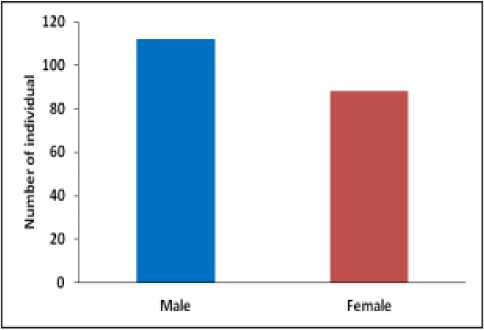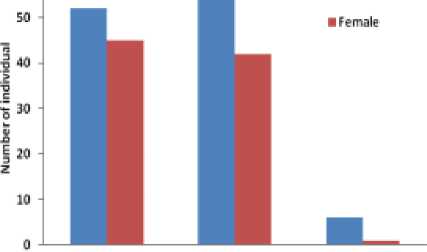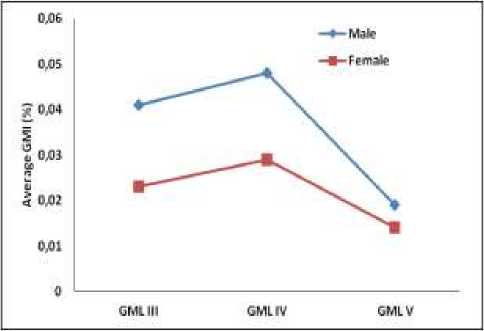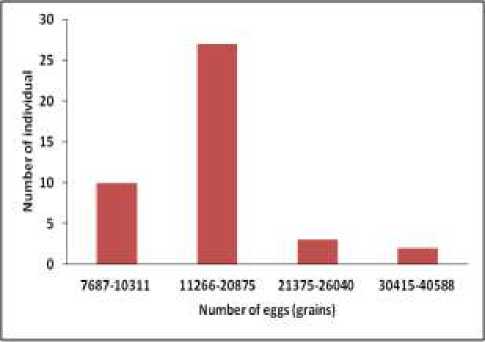The Reproductive Biology of Scad Fish (Decapterus sp.) at Pelabuhan Perikanan Nusantara Pengambengan Jembrana, Bali
on
Advances in Tropical Biodiversity and Environmental Sciences 4(1): 26-29, February 2020 e-ISSN:2622-0628
DOI: 10.24843/atbes.v04.i01.p06 Available online at: https://ojs.unud.ac.id/index.php/ATBES/article/view/58997
26
The Reproductive Biology of Scad Fish (Decapterus sp.) at Pelabuhan Perikanan Nusantara Pengambengan Jembrana, Bali
Odjastira Vidyastari1, Ni Luh Watiniasih2*, Dewa Ayu Angga Pebriani1
1Water Resource Management, Faculty of Marine Science and Fisheries, Udayana University 2Department of Biology, Faculty of Mathematics and Natural Sciences, Udayana University Jl. Kampus Unud Bukit Jimbaran, Kuta Selatan, Badung, Bali
*Correcponding author E-mail: odjastiravt@gmail.com; luhwatiniasih@unud.ac.id
Abstract. Scad fish is one of the economically important fish species, which landed in Pengambengan fishing port. This study aimed to investigate the biological aspects of scad fish such as its growth, measured length and weight, and reproduction aspects such as sex ratio, gonad maturity level (GML), gonad maturity index (GMI), and fecundity. Method in this research is observation. Samples of scad fish were collected every two weeks using the simple random sampling. The total number of samples was 200 fishes, collected from November to December 2019. The result showed that length 18.3-23.06 cm and weight 53.31-112.58 g. The sex ratio of male and female was 1.2:1 consisting of 122 males and 88 females. Scad fish found had 97 fishes GML III, 96 fishes GML IV, and 7 fishes having GML V. GMI value scad fish is 0,014%-0,074%, that fish spawn more than once every year and fecundity was 7687-40588.
Keywords: scad fish; growth; reproduction
-
I. INTRODUCTION
The Pengambengan Nusantara Fisheries Port (later refers as Pengambengan Port), located at Jembrana District of Bali Province, is one of the developing Fisheries Ports in Indonesia and great fishery potential. Pengambengan Port has a strategic role in the development of fisheries and marine affairs, as the center of marine fisheries activities. The dominant fish found caught at Pengambengan Port was pelagic fish. Pelagic fish are groups of free swimming fish that form schooling in their lives, migrating vertically or horizontally close to the surface. One of pelagic fish that can be found in Pengambengan Port was scad fish (Decapterus sp.) Production of scad fish in Pengambengan Port was the second highest nationally in 2017, which caught 1135.30 tons of fish [1].
Scad fish belongs to the Carangidae tribe is commonly found in schooling. The main catching device used to catch scad fish around Pengambengan is the purse seine. The effectiveness and efficiency of purse seine fishing for catching scad fish are greatly influenced by various aspects, one of which is the pattern of the fishing seasons. Season information is used to determine the appropriate time for conducting fishing operations [2].
Uncontrol catch or exploitation without respect to the sustainability of the resources leads to a decrease in resource quality and quantity, which can cause the extinction of the species. Catching pressures due to overfishing, which fishing activities carried out every day
on adult fish either matured and un-matured gonads, will affect the population of scad fish. Lack of brood fish as a result of fishing unmatured female fish was feared to disrupt the reproduction aspects of scad fish and its sustainability.
Catching management of scad fish as one resource needs to be carried out by controlling the size of fish that can be catch. Sustainability of the scad fish can be determined by its potential growth and reproduction, so that fish resources can be optimally utilized. This research aimed to investigate the aspects of growth and aspects of the reproductive biology of scad fish in the Pengambengan Port, by measuring length, weight, sex ratio, gonad maturity level (GML), gonads maturity index (GMI) and fecundity of the fish.
-
II. RESEARCH METHODS
The research was conducted from November 2019 to December 2019 at the port of Pelabuhan Perikanan Nusantara (PPN) Pengambengan, Jembrana, Bali. This Port is located at Jalan Pelabuhan Perikanan No.1, Pengambengan Village, Jembrana. Method in this research is observation. Samples was transported to the Fisheries Laboratory, Faculty of Marine Science and Fisheries, Udayana University for further examination.
Research Procedures
Sample of scads fish were collected 4 times. Fifty samples of fish were taken at a time of collection, every 14
days, for 2 months. The total sample of scad fish collected were 200 fish. Samples were randomly sampled by taking fish randomly from a fishing basket of the fishermen at the port of Pelabuhan Perikanan Nusantara (PPN) Pengambengan. The samples, then transport to the laboratory to measure the total length and weighing the total weight, then the fish was dissected and analyzed the sex ratio and gonad maturity level. Gonad is preserved with 70% alcohol and stored for further analysis of gonad maturity index and fecundity values.
-
III. RESULTS AND DISCUSSION
Length and Weight
Scad fish caught have different lengths and weights with a range of lengths of 18.3-23.06 cm and weights ranging from 53.31-112-58 g. There was no different between the length of males and females scad fish, where the range of length of males fish were 18.3-23.06 cm, while the female was 18.3-22.4 cm (Figure 1). Similarly, the weight of males and females were not difference, in which the range of male was 53.39-112.58 g and the female was 53.31105.17 g. The most fish caught were in the length of 19-20 cm and the weight of 61-79 g (Figure 2).

Figure 1. The range of total length of male and female scad fish landed PPN Pengambengan.
The difference in length and weight of the fish can be caused by differences in growth rate, which is influenced by heredity, age, parasites, disease, food, environmental conditions, migration, as well as differences in sampling time [3]. Fish can have different weights even though the length is the same, because changes in fish weights can result from changes in feed and energy allocation for growth and reproduction [4].
Fish weights were accelerated by the weights of gonad as gonad developed, all metabolism were concentrated on gonad development. The gonad’s weight increased along with gonad maturity [5]. This research found a similar pattern in which increasing gonad maturity, increased the weight of the fish, but decreased after spawning [5]. That differences in the number and size of fish in a population
can be caused by patterns of growth, migration, and new emergence fish in a population and factors that affect fish growth patterns, such as the lack of foods availability that can trigger migration [6]

Figure 2. The range of weight of male and female scad fish landed at PPN Pengambengan
Sex Ratio
The sex ratio was calculated by the ratio of male and female of fish caught. The determination of sex of scad fish was based on its morphological characters. Out of 200 fish samples, the sex ratio found was 1.2:1 (male to female) (Figure 3).

Figure 3. The sex ratio of scad fish landed PPN Pengambengan.
Differences in the number of male and female of fish can be caused by the presence of schooling behavior and uneven distribution between males and females fish, fish mortality, growth and capture factors. That fish that have the same level of gonad maturity, there can be an imbalance in the sex ratio between males and females caused by male fish that have more active than females [7]. In addition, the sex ratio affects the spawning process, because spawning will take place well if the proportion of female fish is similar to male. The proportion of male and female of scad fish can change before and during the spawning season [8]. Spawning of scad fish can be the last long or partial spawning that is releasing eggs gradually over a certain period of time [9].
Gonad Maturity Level (GML)
The distribution gonad maturity level (GML) found from 200 samples of this research was 97 individual of GML III, 96 individual of GML IV and only 7 individual of GML V. The maturity level of scad fish found was highest at GML IV (54%) on Male, but on at GML III (51%) on female. Out of 7 individual that has GML V, 6 of them was male and 1 female (Figure 4).
■ Mak

GMlIII GMLIV GMlV
Figure 4. Gonad Maturity Level (GML) of male and female scad fish landed PPN Pengambengan.
Gonad is a fish's reproductive organ. Gonads of male fish are called testicles which are marked in white to cream and in female fish called ovaries which are marked in orange to red. The female gonads contain egg grains which can be seen visually when matured. The development of the testes and ovaries varies according to the degree of gonad maturity.
The Gonad maturity level of scad fish found during the study was fallen on GML III and IV for both male and female (Figure 4). The development of fish gonad maturity can be caused by genetic characteristics of the population, differences in growth rates, water quality, regional differences, and fishing pressures [10]. The development of gonad was depended on the nutrition supply to the gonad [11]. The weight of gonad increases along with the development of gonad until reach maturity. The gonad maturity level is common as a reference of readiness of fish to spawn or they are in a stage of post spawning.
Gonad Maturity Index (GMI)
Gonad maturity index (GMI) of scad fish found in this study was ranging from 0.014% - 0.074%. Male GMI value was higher than females. The average value of male GMI was almost twice higher (0.041%)) than the value of female GMI (0.023%) at GML III, and almost 3 times at the GML IV (0.048% in males compared to 0.029 in females), however, the value was almost similar at GML V (Figure 5).

Figure 5. The average of Gonad Maturity Index (GMI) of male and female scad fish based on Gonad Maturity Level (GML).
The difference in the GMI is influenced by the gonad and body weight of the fish, because of the greater the gonad and body weight, the higher the GMI. In addition, the gonad maturity level also affects the GMI value, if the gonad maturity level is higher, then the GMI value will also be higher, because with the increase in GML followed by an increase in gonad weight and body weight of the fish. However, this did not happen at GML V of scad fish observed, because the gonad has reached its maximum size, when the fish spawn, then decrease at the end of the spawning period.
When fish do spawning, the GMI value will increase because most of the metabolic yield is directed at gonad development, on the contrary it will decrease after spawning [12]. The value of Gonad maturity index of male and female of scad fish studied was <20%. That fish which have GMI value of less than 20% are groups of fish that can spawn more than once a year [13]. Therefore, the scad fish that have caught and landed at Pengambengan port were multiple spawning fish.
Fish Fecundity
The potential reproduction of scad fish can be identified from its fecundity, namely the number of mature eggs before it will be released at spawning. Scad fish that were ready for spawning predicted on fish that have GML IV with the range of fecundity value of 7687-40588 eggs. However, most fish have the fecundity value ranged from 11266-20875 eggs (Figure 6).
The variation of fecundity in scad fish caught can be influenced by age factors, in which older scad fish have less maximum fecundity compared to young scad fish. The availability of food will also influence the fish fecundity, because if fish get enough food then they can nourish the gonad during its development result in the quality of eggs therefore fecundity.

Figure 6. Fecundity scad fish GML IV
Fecundity is also influenced by egg diameter related to gonad weight, which can be affected by the quality of the environment. A good environment is characterized by a good water quality that is compatible scad fish to live, as well as the absence of predators and parasites and the availability of food for the fish. The fecundity of the scad fish was influenced by body size, age, environment, and egg diameter [14]. The differences in fecundity in each size of fish was due to, among others, that young fish have maximum fecundity compared to old fish, as well as egg quality, especially egg yolk content, food content, large predators and environmental conditions [15].
-
IV. CONCLUSION
The biology of scad fish reproduction (Decapterus sp.) landed at Pengambengan Port have various in length and wight. Male scad fish were more common than female fish with a ratio of 1.2: 1. The fish were mostly at the gonad maturity levels of III and IV. Based on gonad maturity index that the scad fish was spawning more than once a year. The fish fecundity value ranges from 7687-40588 and releases eggs gradually over time.
REFERENCES
-
[1] Adnayana DN. 2018. Kabupaten Jembrana Dalam Angka. Jembrana: BPS Kabupaten Jembrana. 386 hlm. bappeda.jembranakab.go.id. [1 November 2019].
-
[2] Bahdad. 2006. Analysis and Predictive Catch for Skipjack Tuna (Katsuwonus pelamis) In Buton Region Waters South East Sulawesi. [Tesis]. Bogor. Institut Pertanian Bogor.
-
[3] Wulandari Y, Utomo B, Desrita D. 2017.
Pertumbuhan dan Laju Eksploitasi Ikan Kembung (Rastrelliger spp.) di Perairan Selat Malaka Provinsi Sumatera Utara. Aquacoastmarine, 5 (3):1-9.
-
[4] Meretsky VJ, Valdez RA, Douglas ME, Brouder MJ, Gorman OT, Marsh PC. 2000. Spatiotemporal
variation in length-weight relationships of endangered
humpback chub: implications for conservation and management. Transactions of the American Fisheries Society, 129(2):419428.
-
[5] Kusmini II, Putri FP, Prakoso VA. 2016.
Bioreproduksi dan Hubungan Panjang-bobot Terhadap Fekunditas Pada Ikan Lalawak (Barbonymus balleroides). Jurnal Riset Akuakultur, 11(4):339-345.
-
[6] Dahlan MA, Sharifuddin BAO, Joeharnani T, Muhammad N, Moh TU. 2015. Beberapa Aspek Reproduksi Ikan Layang Deles (Decapterus
macrosoma Bleeker, 1841) yang Tertangkap Dengan Bagan Perahu di Perairan Kabupaten Baru, Sulawesi Selatan. Jurnal IPTEKS PSP, 2(3):218-227.
-
[7] Sulistiono, Kurniati TH, Riani E, Watanabe S. 2001. Kematangan Gonad Beberapa Jenis Ikan Buntal (Tetraodon lunaris, T. fluviatilis, T. reticularis) di Perairan Ujung Pangkah, Jawa Timur. Jurnal Iktiologi Indonesia. 1(2):25-30.
-
[8] Bakhris BMW. 2008. Pendugaan Ukuran Pertama Kali Matang Gonad Ikan Layang Deles (Decapterus macrosoma Bleeker). Jurnal Sains dan Teknologi, 4(1):1-8.
-
[9] Calorine PC. 2016. Biologi Reproduksi Ikan Kembung (Rastrelliger faughni Matsui, 1967) di Perairan Selat Sunda. [Skripsi]. Bogor. Fakultas Perikanan dan Ilmu Kelautan. Institut Pertanian Bogor.
-
[10] Laleyeet P, Chikou A, Gnohossou P, Van Dewalle P, Philippart JC, Teugels G. 2006. Studies on the biology of two species of catfish Synodontis schall and Synodontis nigrita (Ostariophysi: Mochokidae) from the Oueme River, Benin. Belgium Journal of Zoology, 136(2):193-201.
-
[11] Atmadi PV, Subagja J, Kristanto AH. 2017. Aspek Biologi Reproduksi dan Pola Pertumbuhan Ikan Uceng (Nemacheilus fasciatus) dalam Pemeliharaan di Akuarium. Media Akuakultur, 12(2):67-74.
-
[12] Wudji A, Suwarso, Wudianto. 2013. Biologi Reproduksi dan Musim Pemijahan Ikan Lemuru (Sardinella lemuru Bleeker 1853) di Perairan Selat Bali. Bawal, Jurnal Widya Riset Perikanan Tangkap, 5(1):49-57.
-
[13] Mariskha PR, Abdulgani N. 2012. Aspek Reproduksi Ikan Kerapu Macan (Epinephelus sexfasciatus) di Perairan Glodonggede Tuban. Jurnal Sains dan Seni ITS, 1(1):27-31.
-
[14] Unus F, Omar SBA. 2010. Analisa Fekunditas dan Diameter Ikan Malalugis Biru (Decapterus
macarellus Cuvier, 1833) di Perairan Kabupaten Banggai Kepulauan, Provinsi Sulawasi Tengah. Jurnal Ilmu Kelautan dan Perikanan, 20 (1):37-43.
-
[15] Effendie MI. 2002. Biologi perikanan. Jogjakarta. Yayasan Pustaka Nusantara.
Discussion and feedback